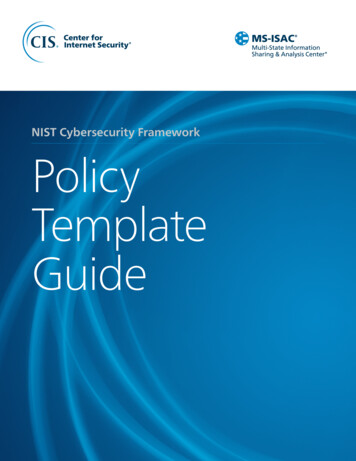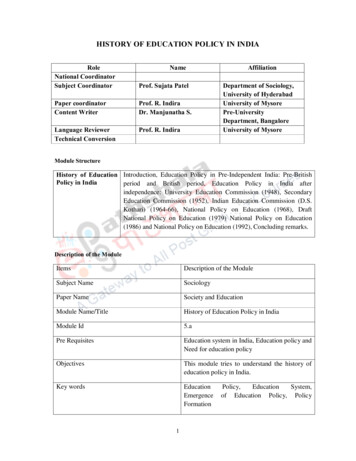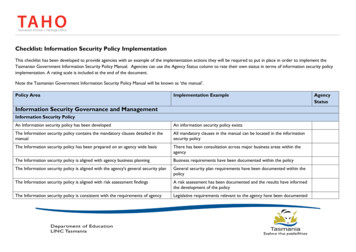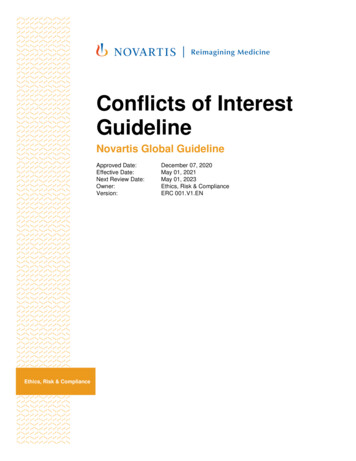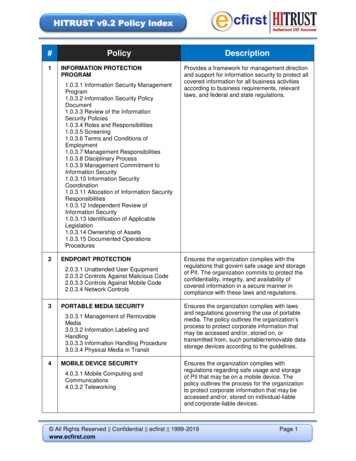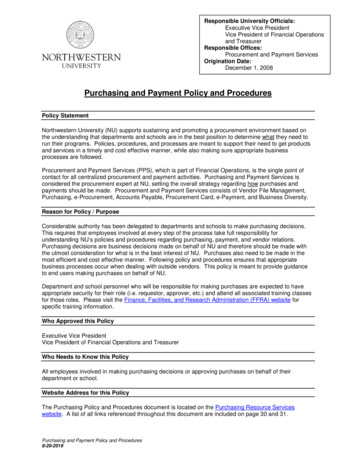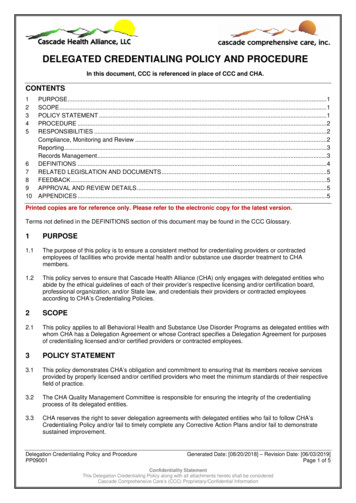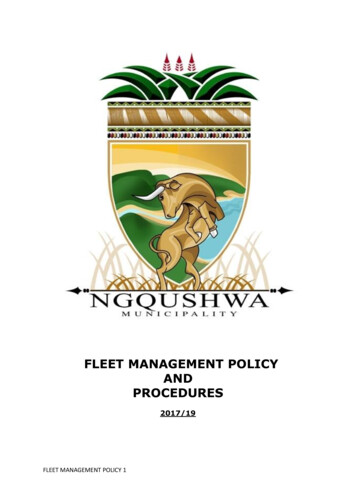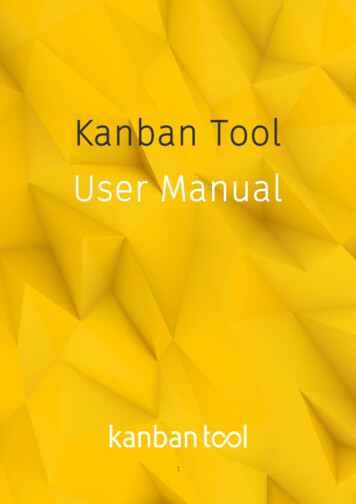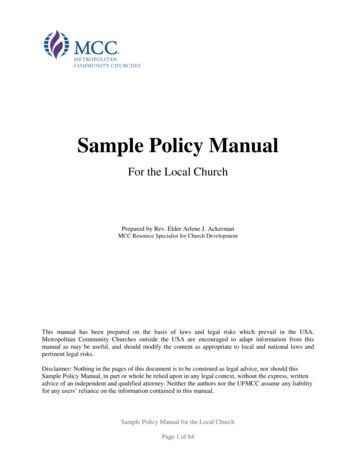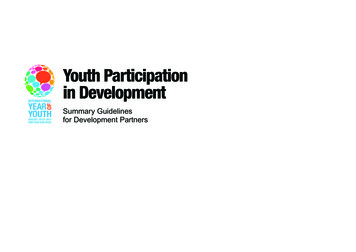
Transcription
Youth Participationin DevelopmentSummary Guidelinesfor Development Partners
CONTENTSP05 - IntroductionP06 - Why work with youthP08 - Youth ParticipationP09 - Policy FrameworksP10 - CaseIntroductionstudies to Case studiesP12 - IntroductionP10Organisational development case studiesP16 - OrganisationalP12Policy and planningdevelopmentcase studiescase studiesP20 - PolicyP16Implementationand planningcasecasestudiesstudiesP24 - ImplementationP20Monitoring and evaluationcase studiescase studiesP26 - MonitoringP24Conclusion and evaluation case studiesP26 - Conclusion2
ACRONYMSAYONAssociation of Youth Organisations NepalDFID UKDepartment for International DevelopmentGTZGerman Technical Co-operationGOYSGovernment Department for Youth and Sport, BahrainMDGsMillennium Development GoalsM&EMonitoring and EvaluationNDPNational Development PlanNORADNorwegian Agency for Development Co-operationNGONon-governmental OrganisationPRSPPoverty Reduction Strategy PaperSRHRSexual and reproductive health and rightsUKUnited Kingdom of Great Britain and Northern IrelandUNUnited NationsUNAIDSThe Joint United Nations Programme on HIV/AIDSUNDPUnited Nations Development ProgrammeUNESCOUnited Nations Economic, Social and Cultural OrganisationUNFPAUnited Nations Populations FundUN-HABITATUnited Nations Human Settlement ProgrammeUNICEFUnited Nations Children’s FundUSAIDUnited States Agency for International DevelopmentWHOWorld Health OrganizationWPAYWorld Programme of Action for YouthWRCWomen’s Refugee CommissionYEAHYoung, Empowered and HealthyYGPYouth Guidance ProjectPURPOSE OF THIS DOCUMENTThe purpose of this document is to:a) Increase understanding of the growing importance of, and greater potentialfor, youth participation in development practice specifically for donor agencies and policy makers.b) Provide some initial practical guidance to assist donor agencies and policymakers to work more effectively with and for young people.This document is a summary of the 2010 publication ‘Youth Participationin Development – A Guide for Development Agencies and Policy Makers.’The original publication was developed by the DFID-CSO Youth WorkingGroup coordinated by Restless Development, working in partnership with DFID,the World Bank, UNICEF, UNFPA and other donor agencies, with contributionsfrom a wide range of civil society partners, all listed in the full publication.This summary document was produced by Restless Development and the United Nations (UN) Programme on Youth. Readers interested to know more aboutthe issues, case studies and tools referenced in this summary document shouldread the full Guide, available from Restless Development, the UN Programme onYouth, or by download at www.ygproject.org.3
“We must fulfil our obligations toyouth. The World Programme of Actionfor Youth asks Governments to considerthe contributions of young persons on allpolicies affecting them. Governments musthonour this commitment. They must alsoincrease the financial, education and technicalsupport made available to young people It ishigh time that we stopped viewing our youngpeople as part of the problem and startedcultivating their promise and potential.”Ban Ki-moon, UN Secretary General, International Youth Day 20074
INTRODUCTIONOverviewThe guide has been developed to assist development partners working withand for youth – including Governments, donor agencies, policy makers, NGOsand civil society [1] – and to increase understanding of the growing importance of,and greater potential for, youth participation in development. The Guide goesbeyond the rhetoric of many policy advocacy papers by exploring key issues andapproaches and providing practical information on how to work with youth atthe operation level in respect of policy and programming. It does this throughthe provision of promising practice case studies that will help organisations toget started. Please note that the full guide (www.ygproject.org) also sets out anumber of quality standards to use as reference.The three-lens approach to youth participationDevelopment assistance should work for the benefit of youth (as target beneficiaries), with youth as partners, and be shaped by youth as leaders [2] (Figure 1).This is an assets approach to youth participation in development which appreciates and mobilizes individual or group talents and strengths, rather than focusingonly on deficits (needs), problems or threats and is referred to as the three-lensapproach to youth participation.It is important for institutions and practitioners to consider all three lenses; theyare not mutually exclusive. Youth participation in development is often a combination of all three. The different lenses may be used with different groups ofyoung people during an intervention/initiative, i.e., young leaders may be reaching out to new groups of young people as targets. The ultimate aim is to develop youth as partners and leaders in development. This is based on youthhaving agency: their capacity to act, their skills and capabilities and their abilityto change their own lives and is the central tenet of the asset based approach toyouth participation.THREE-LENS APPROACH TO YOUTHPARTICIPATION- Working for youth as a beneficiary- Engaging youth as a partner- Supporting youth as leadersKEY OPERATIONALAREAS FOR YOUTHPARTICIPATION- Operational Development- Policy and planning- Implementation- Monitoring and evaluationQUALITY STANDARDSCASE STUDIESGETTING STARTEDSHARING PROMISING PRACTICE – tolearn from, adapt and replicate*Adapted from: World Bank Development report 20071 Throughout the document the term development partners is used and includes policy makers and government partners. The term ‘youth’ is used interchangeably with ‘young people’2 DFID/Maguire, S. (2007) ‘Youth Mapping Study’ – DFID’s Approach to Young People’5
WHY WORK WITH YOUTH?Why work with youth? The demographic imperative: The youth bulgeNearly 50% of the developing world population is youth and children3. There are1.2 billion 15 to 24 year olds in the world and one billion live in developing countries4. This is often referred to as the ‘youth bulge’ 5, as young people constitute ahigh and peaking proportion of many populations.The youth bulge represents both a challenge and an opportunity for development. For example, in Uganda it is estimated that the country needs to createover 600,000 new jobs per year for the next 12 years – equivalent to the totalsize of the formal employment sector at present. If this is not achieved, it will beimpossible to reach the Millennium Development Goals targets, particularly onextreme poverty and hunger (MDG 1), child mortality (MDG 4), and environmental sustainability (MDG 7).These large numbers of young people are an opportunity; an investment.Youth participation in development: Strengthens young people’s abilities to meet their own subsistence needs; Prevents and reduces vulnerabilities to economic, political and socially unstable environments; Promotes ownership and sustainability of interventions; Helps gain entry into target communities and builds up trust and social capital.Defining youthFor statistical purposes, the UN defines youth as individuals between the agesof 15 and 24. Youth do not constitute a homogeneous group; their socio-economic, demographic and geographical situations vary widely both within andbetween regions. Notwithstanding these differences, regional-level analysis provides a general understanding of their development profile. Some 87 per centlive in developing countries and face challenges deriving from limited access toresources, education, training, employment, and broader economic development opportunities6.3 World Bank 20104 2005 figures, UN Population Division, World Population Prospects, 2008 Revision5 Research undertaken by Henrick Urdal at the Uppsala Conflict Data Program, Uppsala University, 2007: high youth bulgesindicate countries ‘at risk’ when combined with economic stresses, but they are not necessarily a predictor of conflict6
However, it is necessary to move beyond the age dimension, and additionallyfocus on the transitional experiences of being young7. This means acknowledging localised cultural understandings of childhood and adulthood. On the onehand, these may construct youth as something which lasts well into one’s 20s- particularly if economic realities exclude young adults from work, home ownership or marriage. On the other hand, in many poverty situations, “adult” care/working responsibilities begin before the age of 158.Why work with youth? Aid effectiveness“By the year 2015,there will be threebillion people underthe age of 25. They arethe future . they arealso the now”James D. Wolfensohn,Former President of the World Bank (2003)Enabling young people to engage with democracy, development and peacebuilding: Enables the exercise of citizenship: making claims and holding governmentsand donor agencies to account (Paris principle:9“mutual accountability.”) Exercise of citizenship rights and duties in youth are durable and often determinepolitical participation later in adulthood10. Participation promotes learning,empowerment and greater control over lives, which enables a wide range ofvoices to be heard. Makes policies and services appropriate for youth: building young people’scommitment to the solutions (Paris principle: “ownership”). Makes the MDGs a reality: the World Bank, UNFPA and the CommonwealthSecretariat have identified youth as critical to reaching the MDGs (Parisprinciple: “managing for results”).Box 1: Youth engagement: success stories Young people and adults share joint responsibility on the advisory board to TheUN-HABITAT Opportunities Fund for Urban Youth-led Development, targetingyouth-led initiatives in slums and squatter settlements that are in urgent need offinancial support (p14). The Municipality of Rosario in Argentina undertakes a participatory youth budgetwhich engages 1,000 youth annually from across its six districts to select representatives and decide upon budget allocations for youth services (p22). In Bahrain, around 16,000 young people aged 15 to 30 (8.9% of the youth population) were engaged directly (through focus group discussions and surveys) or indirectly as part of formulating national youth policy (p16).7 DFID 2007, 2009, World Bank 20078 World Bank 2007, UN 20079 The Paris Principles (adopted by the UN in 1992) relate to the status and functioning ofnational institutions for the protection and promotion of human rights10 World Bank 20077
YOUTH PARTICIPATION: AN OVERVIEWDefining participationParticipation is a commonly used approach and concept within development.Through active participation, young people are empowered to play a vital rolein their own development as well as in that of their communities. The UN haslong recognized that young people are a major human resource for developmentand key agents for social change, economic growth and technological innovation.The World Programme of Action for Youth (WPAY), adopted by the UNGeneral Assembly in 1995 and expanded upon in 2007, provides a policy framework and practical guidelines for national action and international support toimprove the situation of young people. The WPAY identifies the following fifteenpriority areas together with specific objectives and actions: Education Employment Hunger and poverty Health Environment Drug abuse Juvenile delinquency Girls and young women Participation Globalization Information and communication technologies HIV/AIDS Youth and conflict Intergenerational relations Leisure-time activitiesThe General Assembly has reaffirmed its commitment to youth participationsince the adoption of the WPAY. Most recently, in 2009, the General Assemblyadopted resolution 64/130, calling upon Member States to: Recognize young women and men as important actors in conflict prevention,peacebuilding and post-conflict processes; Strengthen the participation of young people, as important actors in the protection, preservation and improvement of the environment as envisioned inAgenda 21; Take measures, including the involvement of boys and young men, to promote Engage young people in the AIDS response, ensure education and employmentopportunities to reduce vulnerability to HIV, provide youth-friendly healthservices Ensure the full and effective participation of youth in the life of society and indecision-making processes by:(a) Creating effective channels of cooperation and information exchange amongyoung people, their national Governments and other decision makers(b) Encouraging and promoting youth-led organizations and the important role theyplay in supporting young people’s civic engagement, capacity-buildingand providingnon-formal education through financial and technical support and promotion of theiractivities;(c) Supporting, including through State and local governments, the establishmentof independent national youth councils or equivalent bodies;(d) Strengthening the participation and inclusion of young persons with disabilities indecision-making processes on an equal basis with others;(e) Providing young people who are disconnected or socially and economically excluded with opportunities to participate in decision-making processes to ensuretheir full involvement in society. .Consider including youth representatives in their delegations at all relevant discussions in the General Assembly, the Economic and Social Council and its functional commissions and relevant United Nations conferences.There is increasing interest in youth participation, driven to some extent by thediscourse on children’s rights [11]. However, this has been limited, and is often onlyat a superficial level, in the sense that young people are often included in oneoff discussions, where their contributions of ‘voice’ do not actually affect corestructural policy decisions.There needs to be a shift in working with young people. Valuing youth as assets:colleagues and stakeholders and having an active appproach to participation iscrucial if development policies are to be truly representative and effective. Theactive, informed and voluntary involvement of young people in decision-makingboth locally and globally is vital if valuing youth as assets is to be achieved.gender equality in all aspects of society and to eliminate violence againstgirls and young women;11 See also Roger Hart’s ladder model of participation. The theory and practice of involving young citizens in communitydevelopment and environmental care’, Earthscan 1997 and Phil Treseder’s adaptation of it in ‘Empowering children andyoung people’, Save the Children 19978
Key national policies Youth policy Poverty Reduction Strategy Papers/National Development Plans Education strategy Adolescent/Sexual and reproductivehealth strategy Employment strategy - in particularnational action plans for youthemployment Rights framework (such as the UnitedNations Convention on the Rights ofthe Child) Gender policy National HIV/AIDS Response PlansPOLICY FRAMEWORKS FOR YOUTHKey international policiesThere has been a growth in policies from bilateral, regional and multilateralagencies, specifically discussing youth in developing countries. They offer a richsource of information on the situation facing youth and how the issue of youthcan be strategically managed. These policies have been used as a basis for theliterature review of the guide. One of the core policies is, ‘The World Programmeof Action for Youth WPAY (2007)’, it provides a policy framework and practicalguidelines for national action and international support to improve the situationof young people around the world. Implementation of WPAY requires the fullenjoyment by young people of all human rights and fundamental freedoms,and also requires that Governments take effective action against violations ofthese rights and freedoms and promote non-discrimination, tolerance, respectfor diversity, with full respect for various religious and ethical values, culturalbackgrounds and philosophical convictions of their young people, equality ofopportunity, solidarity, security and participation of all young women and men.Other key policies include; NORAD (2005). ‘Three billion reasons – Norway’s development strategy forchildren and young people in the south’. Swiss Agency for Development and Cooperation Youth Policy (2007). UNFPA (2010). ‘The case for investing in young people as part of a nationalpoverty reduction strategy’. Commonwealth Secretariat (2007). ‘The Commonwealth Plan of Action forYouth Empowerment 2007-2015’. Danida (2007). ‘Children and Young People in Danish Development Co-operation’. UNFPA (2007) ‘Framework for action on adolescents and youth: openingdoors with young people: 4 keys’. World Bank (2007). ‘World Development Report 2007 – Development andthe next generation’. Africa Commission (2009). ‘Realising the potential of Africa’s youth – report ofthe Africa Commission’.An overview of these policies is provided in the full Guide.9
CASE STUDIESIntroductionThis selection of case studies highlights practical action in respect to youth participation.The guide uses case studies to explore, via thethree-lens approach, the different roles thatyoung people can adopt. They are ‘how-to’models, selected to help donor agencies investigate and learn from the experiences ofothers.Importantly, these models are presented bothas a learning process and also for replication.Note that they are not meant to be taken asstandard because of the need for flexibility inimplementation – they will require adaptation in different social, economic, political andcultural contexts.10
Case study developmentagencies can ensure young people are included as leaders, partners and beneficiaries in local, regional and national decision-making structures.Most case studies in the guide focus on Africa and Asia, mainly sourced frompartners and contacts within the Youth Working Group network via desk-basedresearch in the UK. Case studies represent promising practice and have all beenreviewed by the project committee and members of the wider network to ensure an informed level of quality. They do not represent a complete set of examples for youth participation but they are a solid foundation to begin with,and improve work with and for youth. The expectation is that this guide willpromote youth participation, which will in turn provide more case studies inthe future.Implementation - refers to the delivery of development interventions throughgovernment, civil society or other partners. Young people have an importantrole to play in the implementation of development programmes and initiatives.The roles young people can play include: acting as peer educators in areas suchas sexual & reproductive and health and rights (SRHR), citizenship and democracy, and designing programmes. Taking up these roles can also dramaticallyimprove their own lives, for example through developing skills to increase employability.Case studies are categorised into four areas:Monitoring and Evaluation (M&E) - are integral and distinct parts of strategyand implementation. They are critical tools for forward-looking strategic positioning, organisational learning and for sound management. Young people canbe engaged in a variety of ways including designing indicators and methodology,data gathering, report writing and participating in review processes.Organisational Development - refers to improving an organisation’s structures,systems, and processes; in particular how they work with young people. This isachieved through processes of negotiation, reflection and learning. This sectionof the guide presents case studies about preparing for working with young people and making the first steps. In order to support participation externally, organisations need to practice it internally, demonstrating accountability to youngcitizens. That means bringing younger people into the organisation and its corenetworks and collaborating with them to make subtle adjustments to workingculture where necessary. Young people can bring new, creative and dynamicsuggestions to the table, which can help catalyse improved organisational values and systems. This can be achieved by involving young people as volunteers,interns and staff, and ensuring their representation on boards, committees andtask teams (with guidance and training as necessary).Policy and Planning - refers to the national and regional level developmentplanning processes (e.g., supporting and formulating national developmentplans and poverty reduction strategies) that donor agencies and advisors have akey role to play in managing. In most developing countries young people makeup the majority of the population and development issues disproportionatelyaffect this group. Therefore, they are important stakeholders in planning processes and should be included in every stage. This section explains how donorIn this summary paper, a selection of case studies have been extracted fromthe full guide and been shortened for the purpose of this document. In the fullGuide more case studies can be found and a set of ‘quality standards for youthparticipation’ is put forward for each of the four key areas described here.Genuine participationgives “young people thepower to shape both theprocess and the outcome”UNICEF/Lansdown, 200411
ORGANISATIONAL DEVELOPMENT CASE STUDY:ProcessADVISOR FIELD VISITS (DFID TANZANIA)1. Reality checks are planned and organised with the theme agreed in advance.For this example, government accountability mechanisms was the requestedthematic area to be checked. The implementing partner, Restless Development, then began the process of engaging local government authorities, localNGOs and service providers, local councillors, and citizen groups.Field visits enable a diverse range of community members, including community leaders, youth club members and young women to express their viewpointsto decision-makers. In 2007 DFID Tanzania’s key advisors were brought into direct contact with target beneficiaries. The two-day ‘reality check’ consultationsand visits were an important part of assessing local government accountabilitymechanisms, building on the aims of the DFID Tanzania Country Assistance Plan2006-10.2. A draft timetable was designed and fed back to the relevant DFID representative, discussed and agreed, after which Restless Development led the processof consulting and sensitising participating government personnel. The realitycheck itinerary included meetings with the above groups, project site visits,and focus group discussions with citizens:Objectives Meeting with village executive officer, ward executive offi cer and villagechairperson; To gain direct connection between decision-makers and poor/excludedgroups; School visit and interaction with community action group member; To gain understanding of the success and challenges of implementing policieson the ground, particularly for policy development and implementation; Community festival and youth centre visits. To learn of implementing partner and local government practices in order toassess the reforms needed. Interaction with young people (volunteer peer educators);Results DFID advisors were better able to understand local government operations,which enabled a more effective government accountability strategy to be developed. Increased personal motivation and commitment to development for thepoorest. Clear communication of the co-operative intentions of large institutions regarding the role of poor people in development processes. Increased accountability for effective utilisation of resources and implementation of high-level policies and strategies.Related field-visitsRestless Development: Youth in the community12
ORGANISATIONAL DEVELOPMENT CASE STUDY:YOUNG CONSULTANTS (SAVE THE CHILDREN/MINISTRY OF YOUTH, NEPAL)“Young people are often more provocative and can bring fresh newresearch methodologies or steer an unforeseen but highly informativeavenue of a research project” - Rebecca Calder, Social Development Advisor, DFID NepalInvolving young people in research can allow a greater depth of informationto be gathered, and builds their skills. The Ministry of Youth and Sports, Savethe Children, the Association of Youth Organisations Nepal (AYON) and NepalPlanning Commission carried out a situation analysis of young people by youngpeople in the newly emerging post-conflict country. Young professionals canact as role models for other youth, and participants of the study aspire to be likethe researchers.Objectives To gather information that reflects the situation on the ground;focus group discussions, key-informant interviews, questionnaires and dialogue workshops;6. Tools were piloted and reviewed;7. Young people carried out research and compiled brief district reports;8. The report was finalised by the research consultant.Results An effective way to bring youth participation into professional roles in the organisation; Young people were able to establish strong bonds with local NGOs; Beneficiaries were able to express themselves more openly to their peers and toa gender-balanced team.Related sultants To recruit, train and support young people to be effective researchers.Process1. Calls for applications via ten partners and youth networks;2. Competitive selection, requirement of previous field experience of workingwith young people. Gender balance was also considered, as well as ensuringthere was representation of the different caste and ethnic groups;3. Group discussion involving 15 candidates, enabling young people to demonstrate their skills through a series of tasks including design of research methodology;4. Technical/pastoral support from representatives of the partners, an independent research consultant and two academic advisors;5. Young researchers broke down areas of inquiry and developed guidelines for“The young researchersare more flexible, moreinquisitive and full of zeal;hence they are easy towork with.”Robin Sitaula, executive director, SamriddhiFoundation/research consultant, Status ofYouth in Nepal13
ORGANISATIONAL DEVELOPMENT CASE STUDY:ALLOCATING URBAN YOUTH FUNDS(UN-HABITAT)Donor agencies can play a lead role in demonstrating young people’s capabilities in allocating resources, enhancing the capacity and interest of local andnational governments to address youth issues. Young people and adults sharejoint responsibility on the advisory board to The UN-HABITAT (United NationsHuman Settlement Programme) Opportunities Fund for Urban Youth-led Development.ObjectivesThe special fund supports youth-led initiatives within the following areas: Mobilising young people to help strengthen youth-related policy formulation; Building the capacities of governments, non-governmental and civil societyand private-sector organisations to ensure a better response to the needs andissues of young people; Supporting the development of interest-based information and communication-oriented networks; Piloting/demonstration of new/innovative approaches to employment, goodgovernance, adequate shelter and secure tenure; Sharing and exchange of information on best practices; Facilitating vocational training and credit mechanisms to promote entrepreneurship and employment for young women and men, in collaboration withthe private sector and in co-operation with other UN bodies and stakeholders, Promoting gender mainstreaming in all activities of urban youth.14
Process1. The operational guidelines, structures and application guidelines for the Opportunities Fund were set up through the following processes: Consultation with global youth networks, and collaboration with the UNHABITAT Youth Advisory Board; A review of the Opportunities Fund during the 2009 Dialogue on Investing in Youth-Led Development. This brought together more than 60 grantmakers, researchers, practitioners and youth to discuss how to best supportthe initiative.2. A first call for applications (youth networks and media) was launched inMarch 2009. By June 2009 1,116 applications had been received from youthled organisations in 86 countries.days on different tasks related to processing the applications. Consultants, interns and volunteers were successfully recruited to support this. It is crucial to conduct periodic reviews of youth boards (and the initiativesthey oversee), such as in May 2009 which was conducted by a delegation including the Inter-American Development Bank, World Bank, and United StatesAgency for International Development. Particular costs to consider: travel to the field to support the projects; trainingand capacity building; running a help desk for application processes.Related ng-funds Eligibility checks isolated 315 eligible projects. A majority of applicationsfailed due to not being youth-led, operating in rural areas, or not being related to the objectives of the fund. Quality assessment was conducted andapplications were scored on ten criteria. Many applications scored weaklyon the quality of project design and sustainability.3. More than 30% of short listed projects were from developing countries. An effort was made to include a balance of applications from different sub-regions,different size of grants and different categories of projects.4. The Youth Advisory Board is overseeing the fund. It comprises of 12 advisors,two per UN-HABITAT region, and includes one youth observer (representingyoung people with disabilities). In addition, there are two observer members:one youth representative from informal settlements; and one external advisor,appointed by UN-HABITAT. Advisory board members are elected at theWorld Urban Youth Assembly to serve for a two-year period.Results The overwhelming response to the Youth Opportunities Fund
makers to work more effectively with and for young people. !is document is a summary of the 2010 publication ‘Youth Participation in Development – A Guide for Development Agencies and Policy Makers.’ "e origina
